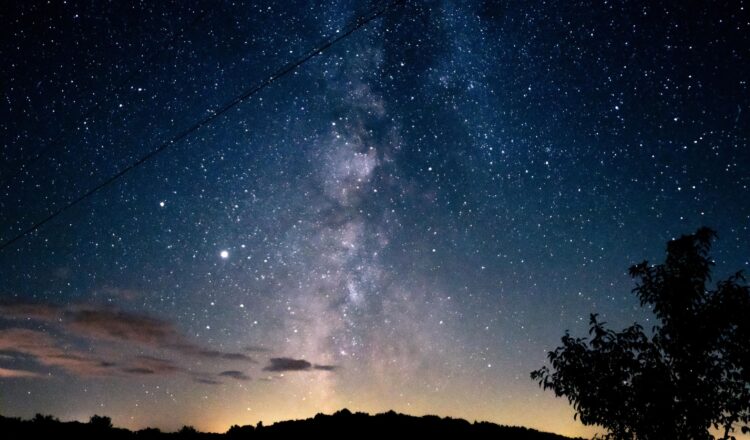By Bob Confer, picture by Mel Hunt
If you live in Allegany County you’re probably a backyard astronomer of sorts. You might find yourself outdoors on a clear night marveling at the countless stars in the heavens. There’s something innate, primeval, about the love affair with the nighttime skies. The universe is fascinating, awe-inspiring, and relaxing – after a day of hustle and bustle and going in a hundred different directions, it’s comforting to look skyward, see that vastness and realize that we and our human experiences are but tiny, inconsequential blips in the whole scheme of things.
Far from the inescapable light pollution of big cities and their suburbs that haunt WNY locales like the Buffalo and Rochester metro areas, we’re blessed in Allegany County with incredible dark skies that lend themselves to great viewing of the cosmos.
As a matter of fact, some people even travel here to take in the nighttime sights.
They plan for it, based on the calendar of events for celestial activities.
You should plan accordingly, too. Mark your calendars now, so you’re ready to get the most out of looking skyward.
To help you plan for skywatching in 2023, here’s a look at some of the nighttime sights on tap for the year.
Lunar eclipses
On the night of October 28th there will be a partial lunar eclipse. To many skywatchers, it will be a letdown when compared to what we saw on the morning of Election Day in 2022. But, with a total lunar eclipse not occurring here again until 2025, you take what you can get.
Only a fifth of the moon will be obscured for New York viewers, but it will be “accessible” – no late-night viewing is necessary. You can see it at dinner time.
Northern Lights
The aurora borealis or northern lights are more abundant when the sun’s face is covered with sunspots and it is emitting all sorts of flares and other solar energy. In recent years, the sun wasn’t too eventful as it was at the bottom of the 11-year sunspot cycle — and that past cycle was somewhat of a dud to begin with. Solar Cycle 25 is well underway and it has been surprising astronomers with its liveliness in 2022.
Still, we are a few years away from the peak of the cycle, so the northern lights won’t be very common — you might even call them downright rare — for our latitude again in 2023 (we aren’t as lucky as northern Canada). But that doesn’t mean the sun won’t surprise us on occasion.
If you want to know when you have a chance, a great tool is the aurora oval (updated every few minutes) on the left side toolbar of the website SpaceWeather.com. If the green or red hue takes over or comes close to the US-Canada border on that map, it’s time to get outside and look. You don’t ever want to miss the northern lights. They are incredible.
The best meteor showers
The Persieds meteor shower never ceases to amaze, throwing some really bright meteors out there. 2016 was an outburst year, and I saw nearly 100 shooting stars over an hour and a half period on the peak night. While 2023’s shower won’t reach such numbers, the Perseids is always a good show. Even during lean years, you can see 30 to 60 per hour, some of them being impressive fireballs, the sight of which will be seared in your memory forever.
In 2023, Perseids will peak on the night of August 12th heading into the morning hours of the 13th. Your best bet is after midnight. Look towards the constellation Perseus to see them in their full beauty. Viewing will be excellent in 2023 as there will be hardly any moonlight to obscure the fireworks (the new moon is on the 16th).
December’s Geminids shower, which is a consistent and totally underrated meteor shower (probably because your average person doesn’t like sitting outside in cold weather), will also be a great one to watch in 2023 because of its nearness to the new moon (which occurs on December 12th). This event will peak overnight December 13th into December 14th. This shower can throw out 50 an hour and, on a really good night, you might get closer top 75 per hour if you can find really dark skies (like those in Alma).

New moons
If you are serious about stargazing, you will as I mark on your calendar every date on which there is a new moon. Basically “no moon,” the new moon ensures there is no moonlight robbing your skywatching experience, meaning you have full visibility of the stars, the Milky Way, meteors and more. You typically have perfect dark sky viewing for four days on either side of the new moon.
New moons will occur on: January 21, February 19, March 21, April 19, May 19, June 17, July 17, August 16, September 14, October 14, November 13, and December 12.
Solar eclipse
While not a nighttime experience like everything else mentioned here, astronomers will have some interest in the solar eclipse set to occur on October 14th. The path of the full eclipse will run from Oregon to Texas, but it will have a slight impact here. If you have special glasses for watching solar eclipses, or a welding helmet, you will be able to see about 25% of the sun obscured.
If you want to see a REALLY good solar eclipse, probably the best of our lifetimes, you won’t have to wait very long. On April 8th, 2024 we will be in the direct path of a total solar eclipse.
Enjoy skywatching in 2023! I hope you nights are filled with meteors, northern lights, and awe.
Love Mel Hunt’s picture? Check out her calendar collection for sale now!!






